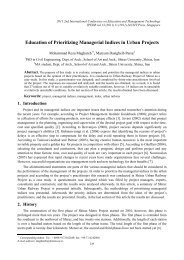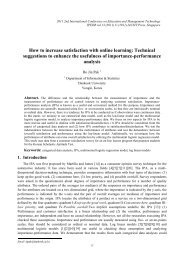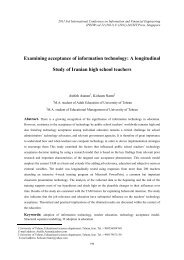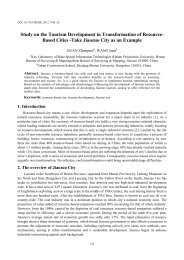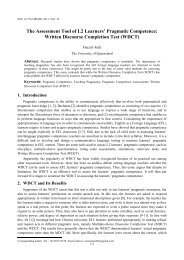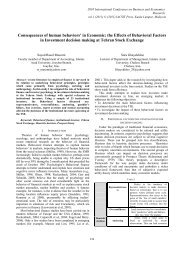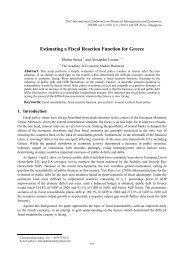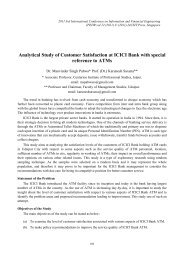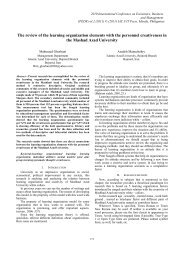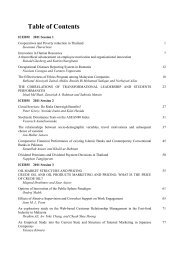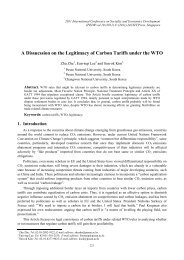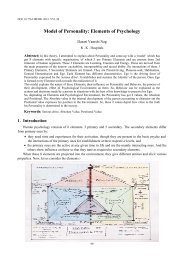Aeta Mag-anchi's Cultural History, Concept of Time and ... - ipedr
Aeta Mag-anchi's Cultural History, Concept of Time and ... - ipedr
Aeta Mag-anchi's Cultural History, Concept of Time and ... - ipedr
Create successful ePaper yourself
Turn your PDF publications into a flip-book with our unique Google optimized e-Paper software.
<strong>Aeta</strong> <strong>Mag</strong>-anchi’s <strong>Cultural</strong> <strong>History</strong>, <strong>Concept</strong> <strong>of</strong> <strong>Time</strong> <strong>and</strong> Territoriality:<br />
Its Implications to Education<br />
Abstract-This ethnographic research work is a pioneering<br />
attempt at underst<strong>and</strong>ing the <strong>Aeta</strong> <strong>Mag</strong>-anchi culture in<br />
particular, <strong>and</strong> its relation to their concepts <strong>of</strong> time <strong>and</strong><br />
territoriality. The study was conducted among the <strong>Aeta</strong> <strong>Mag</strong>anchi<br />
people living at Sitio San Martin <strong>and</strong> Sitio Burog <strong>of</strong><br />
Barangay Sto. Niño, <strong>and</strong> San Vicente, Bamban, Tarlac,<br />
Philippines. The research techniques used were semistructured<br />
interviewing, <strong>and</strong> participant observation. Process<br />
documentation, oral testimonies <strong>and</strong> life histories <strong>of</strong> men <strong>and</strong><br />
women were also taken to support the data gathering process.<br />
The analysis <strong>of</strong> data relied much in the application <strong>of</strong><br />
Phenomenology as its philosophical framework.<br />
Geographically, the <strong>Aeta</strong> <strong>Mag</strong>-anchis determine their territory<br />
as that area where they have been staying since the time they<br />
can remember. It is the area where they have established their<br />
swidden farms because they maintain semi-sedentary<br />
settlement sites. Boundaries are based on the identified<br />
l<strong>and</strong>marks that the older <strong>Mag</strong>-anchis can remember. They<br />
maintain a non-exclusive concept <strong>of</strong> territoriality.<br />
Territoriality has no specific demarcations but based on l<strong>and</strong><br />
usage. This fluidity in terms <strong>of</strong> their concept <strong>of</strong> boundaries is<br />
further reflected in their concept <strong>of</strong> time which is also based on<br />
consciousness rather than linear time. It was found out that<br />
the <strong>Aeta</strong> <strong>Mag</strong>-anchi measures time from his body clock <strong>of</strong> what<br />
we call as human time rather than linear time as what the<br />
westernized Filipinos are using. The absence <strong>of</strong> shared<br />
historical consciousness among the <strong>Aeta</strong> <strong>Mag</strong>-anchis leads to<br />
the absence <strong>of</strong> shared learning experience as a people thus,<br />
their inability to institutionalize their own educational<br />
structures. Since their concept <strong>of</strong> time is based on<br />
consciousness, this affects their historicity as a people. It seems<br />
that these groups have difficulty in establishing a shared<br />
historical experience as people. As they move around, no<br />
particular institutions are kept intact as a group.<br />
Keywords-identity; <strong>Aeta</strong>; Indigenous People<br />
I. INTRODUCTION<br />
This ethnographic research work is a pioneering attempt<br />
at underst<strong>and</strong>ing the <strong>Aeta</strong> <strong>Mag</strong>-anchi culture in particular,<br />
<strong>and</strong> its relation to their concepts <strong>of</strong> time <strong>and</strong> territoriality.<br />
The study was conducted among the <strong>Aeta</strong> <strong>Mag</strong>-anchi<br />
people living at Sitio San Martin <strong>and</strong> Sitio Burog <strong>of</strong><br />
Barangay Sto. Niño, <strong>and</strong> San Vicente, Bamban, Tarlac,<br />
Philippines. Since the study made use <strong>of</strong> ethnography, the<br />
whole tribal group was included in the observation.<br />
2011 International Conference on Social Science <strong>and</strong> Humanity<br />
IPEDR vol.5 (2011) © (2011) IACSIT Press, Singapore<br />
Maria Elena D. David, Ed.D.<br />
University Research Office<br />
Tarlac State University<br />
Tarlac City, Philippines<br />
len_research@yahoo.com<br />
V2-113<br />
The research techniques used were semi-structured<br />
interviewing, <strong>and</strong> participant observation. Process<br />
documentation, oral testimonies <strong>and</strong> life histories <strong>of</strong> men <strong>and</strong><br />
women were also taken to support the data gathering process.<br />
Since time among the <strong>Aeta</strong>s is correlated with the seasons,<br />
the researcher experienced living with the group during those<br />
particular times in order to further support <strong>and</strong> underst<strong>and</strong><br />
previously gathered data.<br />
The analysis <strong>of</strong> data relied much in the application <strong>of</strong><br />
Phenomenology as its philosophical framework. With this<br />
the researcher tried to elevate <strong>and</strong> reveal structures from the<br />
existing culture through explication. The experience that the<br />
researcher had was important in bracketing the natural<br />
attitude <strong>and</strong> disposition <strong>of</strong> the <strong>Aeta</strong> <strong>Mag</strong>-anchi people.<br />
II. STATEMENT OF THE PROBLEM<br />
This study generally focused on the <strong>Aeta</strong> <strong>Mag</strong>-anchi<br />
concept <strong>of</strong> time <strong>and</strong> territoriality <strong>and</strong> its implications to<br />
education. Specifically it sought answers to the following<br />
questions:<br />
• Who are the <strong>Aeta</strong> <strong>Mag</strong>-anchi in terms <strong>of</strong> their<br />
<strong>Cultural</strong> <strong>History</strong>?<br />
• What is the <strong>Aeta</strong> <strong>Mag</strong>-anchi concept <strong>of</strong> time <strong>and</strong><br />
territoriality <strong>and</strong> how are these concepts evident in<br />
their culture?<br />
• What is the relation <strong>of</strong> the above mentioned factors<br />
to formal education?<br />
III. FINDINGS<br />
Very little mention has been made by early writers about<br />
the <strong>Aeta</strong>s. Early writing <strong>of</strong> Philippine history states that the<br />
colonizers knew nothing <strong>of</strong> them except that they were<br />
“small blacks” which roamed in the mountains living on<br />
roots <strong>and</strong> game which they killed with bows <strong>and</strong> arrows.<br />
They were reported to be fierce little savages from whom no<br />
danger could come, since they did not leave their mountain<br />
vastness, but whose territory none dared enters. (Negrito<br />
<strong>Aeta</strong> Paper No. 84, 1908)<br />
At present though, the <strong>Aeta</strong>s are called by different<br />
names: “Ayta”, “Agta”, “Atta”, “Ati” <strong>and</strong> Ita. These<br />
names are usually based on their geographical location,<br />
history, or relationship with other people. Spanish records<br />
show that they were called “Negritos” or “Little Black One”<br />
by the Spanish colonizers. A term they coined from the
word “Negro” meaning dark skinned. In the world<br />
ethnographic literature, at present, they are more popularly<br />
known as Negrito Pygmy. Approximately, the Negrito<br />
Population throughout the Archipelago is roughly 90,000<br />
(NCCP-Pact) they are divided into 25 ethnolinguistic groups<br />
dispersed in b<strong>and</strong>s form Luzon to Mindanao. The most<br />
numerous are those found in the isl<strong>and</strong> <strong>of</strong> Luzon<br />
(Encyclopedia <strong>of</strong> Phil. Arts, Vol. 1, 1994)<br />
Barrows (1910) further explained that the Negrito is a<br />
scattered survivor <strong>of</strong> the pygmy Negro race, at one time<br />
undoubtedly far more important <strong>and</strong> humerous;<br />
brachycephalic, platyrhinian, wooly headed, <strong>and</strong> when<br />
unaffected by the higher culture are forest dwellers.<br />
The <strong>Aeta</strong> <strong>Mag</strong>-anchis belong to this group <strong>of</strong> indigenous<br />
people who inhabit mostly the highl<strong>and</strong>s or mountain regions<br />
<strong>of</strong> the Pampanga - Tarlac area in the Philippines; they have<br />
preserved their ethnic identity through their language, belief<br />
system <strong>and</strong> consciousness. Suitably adapted to their<br />
ecological niche <strong>and</strong> environment, the <strong>Aeta</strong> communities still<br />
employ subsistence patterns practiced by their forebears,<br />
such as hunting, foraging, <strong>and</strong> swidden cultivation. In precolonial<br />
times, their ancestors inhabited the valleys <strong>and</strong><br />
ridges <strong>of</strong> the Pinatubo Area, but were driven into the<br />
interiors when the western colonizers came. (Cojuangco)<br />
Their practice <strong>of</strong> swidden cultivation differentiates the<br />
<strong>Aeta</strong> mag-anchis from other aetas in the sense that they do<br />
not consider themselves as nomadic. Their movement is<br />
only limited within a certain radius in areas which they<br />
consider as a part <strong>of</strong> their territory because they have been<br />
cultivating it.<br />
Swidden cultivation further supports their establishment<br />
<strong>of</strong> settlements usually located at the center <strong>of</strong> their swidden<br />
sites. Since this is their main source <strong>of</strong> livelihood, they are<br />
so much dependent on seasonal <strong>and</strong> ecological changes<br />
which further affects their time management. Unlike the<br />
mainstream western acculturated Filipino who is dependent<br />
on linear time, the <strong>Aeta</strong> <strong>Mag</strong>-<strong>anchi's</strong> concept <strong>of</strong> time is based<br />
on their consciousness despite the presence <strong>of</strong> clocks that<br />
measures linear time.<br />
Territorial boundaries were never defined by the <strong>Aeta</strong>s in<br />
terms <strong>of</strong> concrete boundaries. Again, this is based on their<br />
consciousness <strong>and</strong> is defined with the use <strong>of</strong> markers such as<br />
fruit trees <strong>and</strong> natural demarcations such as rivers <strong>and</strong> ridges,<br />
whatever is present in the area.<br />
Linguistically, the Summer Institute for Linguistics have<br />
identified the <strong>Aeta</strong> <strong>Mag</strong>-anchis as those <strong>Aeta</strong>s living at the<br />
slopes <strong>of</strong> Pinatubo particularly on the Pampanga-Tarlac Area.<br />
<strong>Aeta</strong> mag-anchi as stated by Storck (1991) is a dialect<br />
prevalent among those <strong>Aeta</strong> groups which the SIL have said<br />
to be unique among these people. It is different from the<br />
<strong>Aeta</strong> Zambal spoken by the Abenlen (Abelling) <strong>Aeta</strong>s since<br />
it is Capampangan based <strong>and</strong> the emphasis on the persistent<br />
use <strong>of</strong> the glottal stop among speakers <strong>of</strong> the dialect.<br />
Historically, these <strong>Aeta</strong> <strong>Mag</strong>-anchis have been exposed<br />
to an early acculturation process brought about by the<br />
Spanish Catholic missions in the Bamban area as cited in<br />
early Spanish documents.<br />
During the American regime, they were considered as a<br />
"cultural minority" because they did not easily succumb to<br />
V2-114<br />
the changes that the Americans were implementing. Among<br />
the Filipino Majority population in the area, acculturation<br />
process was made possible through the introduction <strong>of</strong><br />
formal education but the aetas were not educated formally<br />
due to the persistent practices <strong>of</strong> their age old practices.<br />
<strong>Time</strong> to us lowl<strong>and</strong>ers generally can be measured by a<br />
clock, thus translated one day is 24 hours, one hour is 60<br />
minutes <strong>and</strong> one minute is 60 seconds. Through such<br />
measurement, we know when to eat our breakfast, lunch, or<br />
dinner. We know the concept <strong>of</strong> being late because we have<br />
the technological awareness. We have time for going to<br />
work, to school, to rest <strong>and</strong> to sleep. We have a<br />
measurement <strong>of</strong> our age because we know that there are 30<br />
days in a month <strong>and</strong> 12 months or 365 days in a year. More<br />
or less we are bounded by schedules that are stuck around<br />
time. We are made constantly aware <strong>of</strong> it because <strong>of</strong> the<br />
technology called clock thus making us conscious <strong>of</strong> time.<br />
Without the clock, time for us could be measured through<br />
two points in a distance. Thus, we can never give the exact<br />
elapsed time from one point in space through another but<br />
instead we state that approximately the distance for example<br />
from one house to another is measured through number<br />
steps rather than the number <strong>of</strong> minutes.<br />
Our awareness <strong>of</strong> our age can only be made possible<br />
through our awareness <strong>of</strong> seasons because it will be difficult<br />
to remember the number <strong>of</strong> nights that you have slept in as<br />
you grow older without the calendar. Thus, our awareness <strong>of</strong><br />
our past is bounded by material correlates such as the<br />
calendar <strong>and</strong> the clock. Without such, people have to contend<br />
with whatever it is that the group will be able to<br />
institutionalize as time measurement through historical<br />
experience. To a western oriented perception, a person has a<br />
great preoccupation with records, diaries, calendars, time<br />
graphs, etc. To an <strong>Aeta</strong> mag-anchi this clock consciousness<br />
is not present. While the western orientation marks time<br />
with a calendar or watch, the <strong>Aeta</strong> <strong>Mag</strong>-anchi marks time<br />
with his consciousness. Thus, the <strong>Aeta</strong> remembers the past in<br />
terms <strong>of</strong> consciousness <strong>and</strong> not in terms <strong>of</strong> linear time.<br />
Their concept <strong>of</strong> time <strong>and</strong> territoriality which is both tied<br />
to their consciousness largely affect their worldview as a<br />
people. Historical consciousness affects the identity <strong>of</strong><br />
people. Hence, common historical experience molds<br />
common identity (Shimizu, 1989). However, since the aeta<br />
concept <strong>of</strong> time is not the same as the mainstream<br />
westernized Filipino, a vacuum exist in their historical<br />
experience as a people. Meaning, there is no collective recall<br />
<strong>of</strong> the past based on chronological account. Which makes our<br />
historical experience different from theirs. This is further<br />
affected by the fluidity by which they perceive time. In turn,<br />
education is seen to be a vehicle in molding the historical<br />
identity <strong>of</strong> people. Historical consciousness is passed<br />
through generation through learning. However, to an aeta<br />
<strong>Mag</strong>-anchi, the absence <strong>of</strong> historical consciousness means<br />
their inability to maintain structures that would transmit<br />
historical learning through succeeding generation. Education<br />
to an <strong>Aeta</strong> <strong>Mag</strong>-anchi is focused only on the ability to<br />
maintain day to day survival techniques rather than an<br />
institution which could transmit historical consciousness as a<br />
people.
In spite <strong>of</strong> government efforts to respond to the needs <strong>of</strong><br />
these groups, the education <strong>of</strong> their children has not been<br />
well attended to. The <strong>Aeta</strong> children have been neglected in<br />
terms <strong>of</strong> education. Only some or a few among them are<br />
attending schools or are able to attend school. This has been<br />
partly attributed to the fact that barangay schools are usually<br />
located in the lowl<strong>and</strong>s <strong>and</strong> are thus quite remote from the<br />
settlement <strong>of</strong> the tribal communities. <strong>Time</strong> is mostly used up<br />
in going to <strong>and</strong> from the school. Although public schools are<br />
free, parents still cannot send their children because they<br />
could not afford to pay the school fees imposed.<br />
These among others have been partly the reason <strong>of</strong> why<br />
the <strong>Aeta</strong> <strong>Mag</strong>-anchis despite long exposure to lowl<strong>and</strong><br />
culture have a lot <strong>of</strong> difficulty in accepting formal education.<br />
However, their identity <strong>and</strong> consciousness as a people can<br />
also be used to explain their inability to adapt to formal<br />
education.<br />
At present, for an <strong>Aeta</strong> <strong>Mag</strong>-anchi, education is seen both<br />
as a threat to their existing culture <strong>and</strong> at the same time a<br />
vehicle to a better life. Threat because, those who will be<br />
educated will be entirely acculturated to the mainstream<br />
population, <strong>and</strong> vehicle because being educated means being<br />
able to facilitate their economic exchange with lowl<strong>and</strong><br />
markets. (Orejas, 1999)<br />
The current educational setup implements the same<br />
national curriculum to all schools, private or public, <strong>and</strong> the<br />
tribal communities go through the same system <strong>of</strong> learning.<br />
The curriculum, however, retains its western framework<br />
despite efforts to adapt it to a nationalistic consciousness; it<br />
is therefore foreign. As a consequence, the children have<br />
been experiencing a sort <strong>of</strong> a cultural shock <strong>and</strong> have been<br />
traumatized. The main problem lies in the fact that the<br />
children who attends the same class come from different<br />
cultural settings with varied enculturation <strong>of</strong> socialization,<br />
<strong>and</strong> world-views. Moreover, it is important to learn <strong>and</strong><br />
underst<strong>and</strong> that the situation in itself is a factor in the<br />
negative attitude <strong>of</strong> the tribal communities.<br />
This being the case, it is therefore important that the<br />
curriculum to be used in educating these people should be<br />
responsive to their culture <strong>and</strong> identity as a people.<br />
IV. CONCLUSIONS<br />
The <strong>Aeta</strong> <strong>Mag</strong>-anchi <strong>of</strong> Sacobia Tarlac belongs to the<br />
Pinatubo Ayta Group as identified by Fox in 1943, which<br />
settled on the lower slopes <strong>of</strong> Mt. Pinatubo towards the<br />
direction <strong>of</strong> the Pampanga-Tarlac Area. They are<br />
linguistically distinct from other Pinatubo Aytas because <strong>of</strong><br />
their dialect, Capampangan based rather than Sambali based<br />
<strong>and</strong> uses a glottal stop in between words during<br />
pronunciation. Since they are swidden cultivators, their<br />
movement is largely determined by change in swidden sites<br />
rather than by nomadic shifts.<br />
Long before they were subjected to lowl<strong>and</strong> incursions,<br />
the <strong>Aeta</strong> <strong>Mag</strong>-anchis held on their notion <strong>of</strong> territoriality.<br />
Subsumed in their practice <strong>of</strong> l<strong>and</strong> use are the three basic<br />
concepts denoted by English terms, habit, custom <strong>and</strong> law.<br />
Among the <strong>Aeta</strong> <strong>Mag</strong>-anchi there are no distinction made<br />
between the concepts <strong>and</strong> there is no equivalent term <strong>of</strong><br />
conquest that denotes acquisition <strong>of</strong> property. Notions <strong>of</strong><br />
V2-115<br />
homel<strong>and</strong> are connected to a habitual usage <strong>of</strong> anything in<br />
the surrounding that leads to communal patterns <strong>of</strong> behavior<br />
<strong>and</strong> customary laws. Territoriality has no specific<br />
demarcations but based on l<strong>and</strong> usage.<br />
This fluidity in terms <strong>of</strong> their concept <strong>of</strong> boundaries is<br />
further reflected in their concept <strong>of</strong> time which is also based<br />
on consciousness rather than liner time. It was found out that<br />
the <strong>Aeta</strong> <strong>Mag</strong>-anchi measures time from his body clock <strong>of</strong><br />
what we call as human time rather than linear time as what<br />
the westernized Filipino are using.<br />
It should be further stated that due to their fluidity in<br />
movement which is usually related to their economic l<strong>and</strong><br />
use which is swidden cultivation, the aeta mag-anchi were<br />
unable to maintain established social institutions other than<br />
that <strong>of</strong> the family grouping that will take care more complex<br />
needs <strong>of</strong> the group hence the non-formation <strong>of</strong> formal<br />
educational structures. This emanates from the preliterate<br />
concept <strong>of</strong> education <strong>of</strong> the aeta <strong>Mag</strong>-anchi where in they<br />
conceptualized education only as a preparation <strong>of</strong> the young<br />
for his future performance <strong>of</strong> roles as an adult. But then, it is<br />
important to note that within their society there are no highly<br />
specialized role differentiation except for sex <strong>and</strong> age roles.<br />
This makes their concept <strong>of</strong> education limited to training the<br />
young only in as much as the performance <strong>of</strong> such roles.<br />
Therefore, upon exposure to lowl<strong>and</strong> incursions <strong>and</strong><br />
acculturation process, the <strong>Aeta</strong> <strong>Mag</strong>-anchi has this inherent<br />
inability to adapt to the formalized structure <strong>of</strong> the<br />
classroom mainly because the formalized structure goes<br />
against his inherent concept <strong>of</strong> education. Formal education<br />
then is seen as irrelevant in training the young <strong>Aeta</strong> to serve<br />
his family.<br />
ACKNOWLEDGMENT<br />
The author acknowledges the Tarlac State University<br />
Graduate School <strong>and</strong> the respondents in the study.<br />
REFERENCES<br />
[1] Barrows, David P. 1910. "The Negrito <strong>and</strong> Allied Types in the<br />
Philippines", American Anthropologist, Vol 12, No. 3, July-Sept.,<br />
1910.<br />
[2] Dizon, Lino. L. 1998. East Of Pinatubo. Former recollect Missions<br />
in Tarlac <strong>and</strong> Pampanga (1712-1898). Quezon City: Museo-Archivo<br />
Recoletos.<br />
[3] Dy, Manuel B. Jr. Philosophy <strong>of</strong> Man: Selected Readings. Manila:<br />
Goodwill Trading, 1986.<br />
[4] Elkins, Daniel R. et.al. (1994) Ya Luta Tamo. Manila" Summer<br />
Institute <strong>of</strong> Linguistics<br />
[5] Fox, Robert B. 1952. "The Pinatubo Negritos: Their Useful Plants<br />
<strong>and</strong> Material Culture." The Philippine Journal <strong>of</strong> Science 81.<br />
[6] Malicsi, Jonathan. (1982) "On the Sambal Ayta <strong>Concept</strong> <strong>of</strong> Beauty",<br />
Readings in Philippine Socio-Linguitics. Dela Salle University.<br />
[7] Oracion, Enrique G. The Ecology <strong>of</strong> Ethnic Relations: The Case <strong>of</strong><br />
the Negritos <strong>and</strong> the Upl<strong>and</strong> Cebuanos in Southern Negros,<br />
Philippines.” .” Convergence, Vol 2 (Hope M. B<strong>and</strong>al, Ed.)<br />
Dumaguete: Silliman University Press.<br />
[8] Orejas, Tonette (1999). "Teachers Urge Distinct Curriculum for <strong>Aeta</strong><br />
Students", Philippine Daily Inquirer.<br />
[9] Shimizu, Hiromu. Pinatubo Aytas: Continuity <strong>and</strong> Change. Quezon<br />
City: Ateneo De Manila University Press, 1989.<br />
[10] Sicat, Rodrigo M. "Indigenous Learning Systems", TSU Graduate<br />
School Journal.
[11] Storck, Margarete. Mamasa Kitamoy Na. Manila: Summer Institute<br />
<strong>of</strong> Linguistics. 1991.<br />
_______________. 1985. Sacobia: The Making <strong>of</strong> a Rural Model<br />
Community. Manila: SDA.<br />
[12] Tadem, Eduardo C. 1994. "Integrated Rural development <strong>and</strong> U.S.<br />
Basel<strong>and</strong>s in the Philippines: The Sacobia Project", Kasarinlan, Vol.9,<br />
Nos. 2&3, 4th Quarter.<br />
________________. 1994 "<strong>Aeta</strong>", Encyclopedia <strong>of</strong> the Philippine<br />
Arts. Vol.1.<br />
B. Unpublished Materials<br />
[13] Capitulo, Louella P. "The Persistence <strong>of</strong> Folk Medicine Among the<br />
Christianized Aburlin Negritos <strong>of</strong> Western Tarlac". Term Paper,<br />
Ateneo de Manila University, 1990.<br />
[14] Cojuangco, Margarita. "The Baluga <strong>of</strong> Tarlac in the Military:<br />
Historical Notes, Realities, <strong>and</strong> Prospects.<br />
[15] Cosme, Ernesto. 1974. "Inarraro Negritos: A Case Study in<br />
Education <strong>and</strong> Culture." Ph.D. Disseration, Centro Escolar University,<br />
Manila.<br />
V2-116<br />
[16] Dumagat, Fay L., 1974. "Social Change in an Itneg (Tinggian)<br />
Community: 1723-1941." Unpublished Master’s Thesis, Asian<br />
Center, University <strong>of</strong> the Philippines.<br />
[17] Dumagat Fay L., 1988. "Itneg (Tinggian) Justice <strong>and</strong> Conflict<br />
Resolution." Quezon City: Ph.D. Dissertation, Asian Center,<br />
University <strong>of</strong> the Philippines.<br />
[18] Gaabucayan, Samuel Paez. "A Socioeconomic Study <strong>of</strong> the Pinatubo<br />
Negritos <strong>of</strong> the Pampanga -Tarlac Area". Dissertation (Anthropology).<br />
CSSP: university <strong>of</strong> the Philippines, 1978.<br />
[19] Gloria, Heidi K. "Exploring the <strong>Cultural</strong> L<strong>and</strong>scape <strong>and</strong> Ethnic<br />
Boundaries <strong>of</strong> Indigenous Peoples in Mindanao." Paper presented<br />
during the 19th National Conference <strong>of</strong> the Ugnayang Pang-agham<br />
Tao (Anthropological Association <strong>of</strong> the Philippines), October 29-31<br />
1997, Puerto Princesa,Palawan.<br />
C. Micr<strong>of</strong>ilms<br />
[20] Del Fiero, Vito N. "The <strong>Aeta</strong>s <strong>of</strong> Zambales" The Luther Parker<br />
Collection. University <strong>of</strong> the Philippines, 1918.<br />
[21] Lumanlan, Prudencio. The Negritos <strong>of</strong> Pampanga." Negrito <strong>Aeta</strong><br />
Paper No. 84. The Luther Parker Collection. University <strong>of</strong> the<br />
Philippines, 1918.



